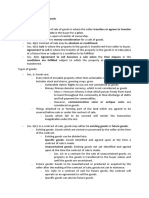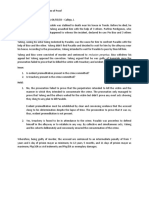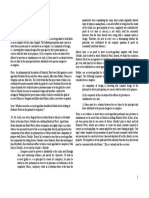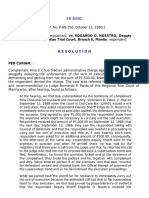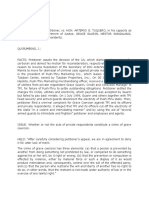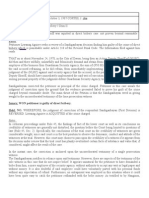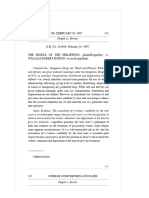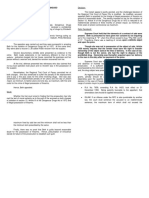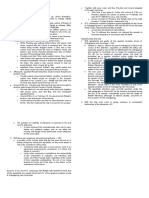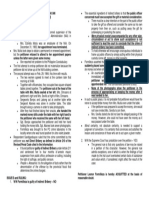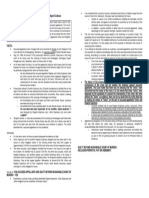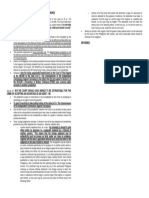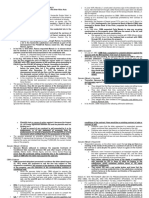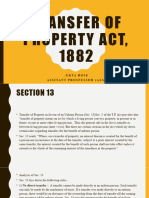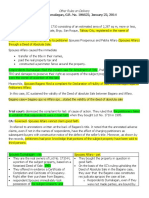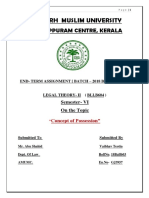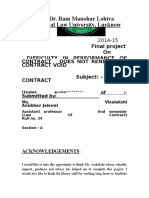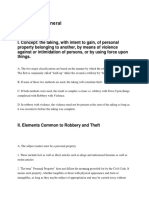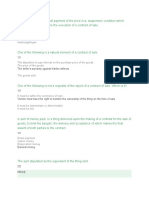People vs. Burton
People vs. Burton
Uploaded by
Le AnnCopyright:
Available Formats
People vs. Burton
People vs. Burton
Uploaded by
Le AnnCopyright
Available Formats
Share this document
Did you find this document useful?
Is this content inappropriate?
Copyright:
Available Formats
People vs. Burton
People vs. Burton
Uploaded by
Le AnnCopyright:
Available Formats
PEOPLE VS.
BURTON he were penalized under the new law, he would have to bear the
Panganiban [February 19, 1997] minimum fine of P500,000.00.
Thus, retrospective application of Republic Act No. 7659, the
FACTS: heinous crimes law would prove more burdensome upon the
At about 9:30 PM of December 26, 1992, accused William Burton y accused and would contradict the basic principle that all
Robert, 30 years old, a British national, checked in at the Ninoy penal laws shall be interpreted in favor of the accused.
Aquino International Airport (NAIA) for his trip to Sydney, Australia.
The accused had two pieces of luggage with him which he passed 2. W/N he is guilty of the crime of attempting to transport hashish – YES
through the x-ray machine at the departure area of the airport. Appellant questions the trial courts conferment of faith and
The machine showed certain portions of the sidings and bottom of the credence on the testimony of prosecution witness. It is a well-
bags to be dark in color, making its operator to suspect that something entrenched rule in law that the assessment of a witness
illegal was inside them. credibility by the trial court is accorded great respect
The accused, together with his two pieces of baggage, was brought to The accused argues that there can be no conviction unless
the Customs Office at the NAIA, where, with his consent, the sidings the prosecution shows that the accused knowingly possessed
of one bag and the bottom of the other were slashed open. the prohibited articles. Under the Rules of Evidence (Sec. 3[j],
o Found inside were hashish, a derivative of marijuana, Rule 131, Rules of Court), things which a person possesses,
which totaled a weight of 5.6 kilograms. or exercises acts of ownership over, are owned by him.
During his investigation, the accused was observed to be walking in o In several cases, the Court has held that possession
an uneasy manner. of a considerable quantity of marijuana cannot
o Retrieved from inside the shoes were four (4) blocks of the indicate anything except the intention of the accused
same dark substance. to sell, distribute and deliver said prohibited drug.
Hashish is a prohibited drug under Republic Act No. 6425, o The existence of animus possidendi or knowledge of
otherwise known as The Dangerous Drugs Act of 1972. possession is only prima facie and is subject to
The trial court convicted him of attempting to transport prohibited contrary proof and may be rebutted by evidence that
drugs under Section 4, in relation to Section 21 of RA 6425. the accused did not in fact exercise power and control
o He was sentenced to life imprisonment and a fine of over the thing in question, and did not intend to do so.
P20,000. o The burden of evidence is thus shifted to the
possessor to explain absence of animus possidendi.
RELEVANT ISSUE/S and RULING: A mere uncorroborated claim of the accused that he
1. W/N life imprisonment and a fine of P20,000 were the proper did not know that he had a prohibited drug in his
penalties – YES possession is insufficient.
The crime was committed on December 26, 1992 or about a year
before Republic Act No. 7659 (which imposes the penalty of
reclusoin perpetua to death) came into effect on December 31,
1993. TRIAL COURT’S IMPOSITION OF THE PENALTY OF LIFE IMPRISONMENT
Retroactive application of said law would not be advantageous AND A FINE OF P20,000 AFFIRMED.
to the accused in view of the increased range of penalty and
conjunctive fine prescribed, where the quantity of prohibited
drugs is 750 grams or more.
First, cases wherein life imprisonment is, unlike reclusion
perpetua, does not carry accessory penalties. In the event that
Republic Act No. 7659 is applied retrospectively to the accused,
he has to suffer not only reclusion perpetua but also the
accessory penalties.
Second, the fine imposed upon appellant is the minimum
imposable of twenty thousand pesos (P20,000.00), whereas if
You might also like
- Dolera v. People DigestDocument3 pagesDolera v. People Digestdylabolante921No ratings yet
- Soga Note MalaysiaDocument27 pagesSoga Note MalaysiaDinmail TumblrNo ratings yet
- People V Burton: Plaintiff-Appellee: Accused-Appellant: FactsDocument1 pagePeople V Burton: Plaintiff-Appellee: Accused-Appellant: FactsEstee XoohNo ratings yet
- Burton DigestDocument1 pageBurton DigestYanaglyzzaNo ratings yet
- Sison Vs PeopleDocument6 pagesSison Vs PeopleMark DungoNo ratings yet
- People vs. NaagDocument2 pagesPeople vs. NaagGia DimayugaNo ratings yet
- Estrella Vs SandiganbayanDocument1 pageEstrella Vs Sandiganbayanjobelle barcellanoNo ratings yet
- People vs. EjandraDocument5 pagesPeople vs. EjandraLouise QueridoNo ratings yet
- CRIM Batch 5Document10 pagesCRIM Batch 5Rachelle CasimiroNo ratings yet
- Astorga V People 437 SCRA 152Document13 pagesAstorga V People 437 SCRA 152Anonymous Jxr6hoduaNo ratings yet
- People v. Elijorde, 306 SCRA 188 (1999Document5 pagesPeople v. Elijorde, 306 SCRA 188 (1999Glenn caraig100% (1)
- People V Magabo G.R. No. 139471 January 23, 2001Document2 pagesPeople V Magabo G.R. No. 139471 January 23, 2001John YeungNo ratings yet
- Ty Vs People 439 SCRA 220 (2004)Document2 pagesTy Vs People 439 SCRA 220 (2004)Claudine Sumalinog100% (1)
- 37 - Dujon v. Ampatuan, GR No. 188707 (Tan)Document2 pages37 - Dujon v. Ampatuan, GR No. 188707 (Tan)Nica Cielo B. LibunaoNo ratings yet
- People vs. TabugocaDocument9 pagesPeople vs. TabugocaMNo ratings yet
- People Vs Sanchez, 250 Scra 14Document12 pagesPeople Vs Sanchez, 250 Scra 14Add AllNo ratings yet
- People V RocheDocument1 pagePeople V RocheJaz SumalinogNo ratings yet
- People vs. BanezDocument21 pagesPeople vs. BanezFlo PaynoNo ratings yet
- Buenavista v. Garcia FactsDocument17 pagesBuenavista v. Garcia FactsMacabebe Fire StationNo ratings yet
- Us Vs SimeonDocument2 pagesUs Vs SimeonDat Doria PalerNo ratings yet
- People V RosasDocument1 pagePeople V RosasKat JolejoleNo ratings yet
- People vs. Tac AnDocument2 pagesPeople vs. Tac AnShanelle Tamayo NapolesNo ratings yet
- Crim Law Digests 1Document39 pagesCrim Law Digests 1kai lumagueNo ratings yet
- Quizo V SandiganbayanDocument1 pageQuizo V SandiganbayanDAblue ReyNo ratings yet
- 10.pabalan v. Guevarra 74 SCRA 53 PDFDocument6 pages10.pabalan v. Guevarra 74 SCRA 53 PDFaspiringlawyer1234No ratings yet
- People V. Ancheta 431 SCRA 42, JUNE 4, 2004: Band - A Crime Is Committed by A Band When atDocument1 pagePeople V. Ancheta 431 SCRA 42, JUNE 4, 2004: Band - A Crime Is Committed by A Band When atLyra BalitosNo ratings yet
- People vs. RegalaDocument1 pagePeople vs. RegalaMrln Vloria0% (1)
- People Vs Balag-EyDocument2 pagesPeople Vs Balag-EyopislotoNo ratings yet
- People v. BañezDocument2 pagesPeople v. BañezKathleen del RosarioNo ratings yet
- Layola Vs Gabo, JRDocument2 pagesLayola Vs Gabo, JRAlexander VangaughtNo ratings yet
- 26.chua V Nuestro 190 Scra 424 PDFDocument2 pages26.chua V Nuestro 190 Scra 424 PDFaspiringlawyer1234No ratings yet
- People V JaranillaDocument3 pagesPeople V JaranillaTriciaNo ratings yet
- Castro Vs CA (1989)Document3 pagesCastro Vs CA (1989)Anonymous e3d4NYgnNKNo ratings yet
- United States v. Lim BuancoDocument5 pagesUnited States v. Lim BuancoJolas E. BrutasNo ratings yet
- People V LaurioDocument1 pagePeople V LaurioDominic BenjaminNo ratings yet
- 61 People-v-Rebucan DIGESTDocument1 page61 People-v-Rebucan DIGESTRexNo ratings yet
- People vs. ElicanalDocument9 pagesPeople vs. ElicanalReyrhye RopaNo ratings yet
- Chang vs. PeopleDocument1 pageChang vs. PeopleFVNo ratings yet
- Destruction of Life A. Elements of ParricideDocument10 pagesDestruction of Life A. Elements of ParricideFrederick Ivan DaclizonNo ratings yet
- People of The Philippines Vs NogpoDocument3 pagesPeople of The Philippines Vs NogpoannaNo ratings yet
- Case 575 SCRA 102Document2 pagesCase 575 SCRA 102Jezelle Gois100% (1)
- CASE #9. G.R. No. 123979Document5 pagesCASE #9. G.R. No. 123979Save AngelesNo ratings yet
- People V Lug-AwDocument17 pagesPeople V Lug-AwNico de la PazNo ratings yet
- 11 People v. SespeneDocument2 pages11 People v. SespeneRay MondNo ratings yet
- People Vs UlepDocument10 pagesPeople Vs UlepryuseiNo ratings yet
- 17.manipon v. Sandiganbayan 143 SCRA 267 PDFDocument7 pages17.manipon v. Sandiganbayan 143 SCRA 267 PDFaspiringlawyer1234No ratings yet
- Onate vs. AbrogarDocument5 pagesOnate vs. AbrogarAlexylle Garsula de ConcepcionNo ratings yet
- Herminio Buenaventura vs. People G.R. NO. 171578, AUGUST 8, 2007Document3 pagesHerminio Buenaventura vs. People G.R. NO. 171578, AUGUST 8, 2007Ines Hasta JabinesNo ratings yet
- Peole Vs Cano 413 SCRA 92Document3 pagesPeole Vs Cano 413 SCRA 92rey50% (2)
- Aguirre vs. People - DigestDocument2 pagesAguirre vs. People - DigestMaria Jennifer Yumul BorbonNo ratings yet
- PP v. SabadoDocument2 pagesPP v. SabadoAngelica EvansNo ratings yet
- (DIGEST) People vs. Pinca, 318 SCRA 270, November 17, 1999Document2 pages(DIGEST) People vs. Pinca, 318 SCRA 270, November 17, 1999RexNo ratings yet
- People v. Valdez, 159 SCRA 153 (1988)Document9 pagesPeople v. Valdez, 159 SCRA 153 (1988)Glenn caraigNo ratings yet
- Us Vs EduaveDocument2 pagesUs Vs EduaveJoyleen HebronNo ratings yet
- Delos Reyes Vs People - SiasatDocument1 pageDelos Reyes Vs People - Siasatpinkblush717No ratings yet
- 09-People Vs BurtonDocument24 pages09-People Vs BurtonthelawanditscomplexitiesNo ratings yet
- Plaintiff-Appellee Accused-Appellant The Solicitor General Cecilia S. RiveraDocument10 pagesPlaintiff-Appellee Accused-Appellant The Solicitor General Cecilia S. RiveraGina RothNo ratings yet
- Footnote Case Title Date Ponente FactsDocument57 pagesFootnote Case Title Date Ponente FactsFahmie PagayawanNo ratings yet
- People Vs GangosoDocument2 pagesPeople Vs GangosoLisa GarciaNo ratings yet
- People v. MontillaDocument22 pagesPeople v. MontillaqwertyanonNo ratings yet
- Consti HW 4 Searches and Seizures p2Document116 pagesConsti HW 4 Searches and Seizures p2Jon Mayette SalacupNo ratings yet
- Enriquez vs. LavadiaDocument1 pageEnriquez vs. LavadiaLe AnnNo ratings yet
- People vs. MontanirDocument2 pagesPeople vs. MontanirLe AnnNo ratings yet
- Formilleza vs. SandiganbayanDocument1 pageFormilleza vs. SandiganbayanLe AnnNo ratings yet
- PLR Final Political Law Review Syllabus (Second Sem 2019-2020) PDFDocument19 pagesPLR Final Political Law Review Syllabus (Second Sem 2019-2020) PDFLe AnnNo ratings yet
- People vs. PacificadorDocument1 pagePeople vs. PacificadorLe AnnNo ratings yet
- People vs. MontanirDocument2 pagesPeople vs. MontanirLe AnnNo ratings yet
- Motion To Consolidate: Splitting of A Single Cause of ActionDocument2 pagesMotion To Consolidate: Splitting of A Single Cause of ActionLe Ann100% (1)
- People vs. LikiranDocument2 pagesPeople vs. LikiranLe AnnNo ratings yet
- People vs. EspinozaDocument1 pagePeople vs. EspinozaLe AnnNo ratings yet
- Government vs. Phil. Sugar EstatesDocument1 pageGovernment vs. Phil. Sugar EstatesLe AnnNo ratings yet
- PSE vs. LitonjuaDocument1 pagePSE vs. LitonjuaLe AnnNo ratings yet
- Lim vs. CADocument2 pagesLim vs. CALe Ann100% (1)
- Tan v. HonasanDocument3 pagesTan v. HonasanLe AnnNo ratings yet
- Filipinas Port vs. NLRC (1991)Document2 pagesFilipinas Port vs. NLRC (1991)Le AnnNo ratings yet
- People vs. TanDocument1 pagePeople vs. TanLe AnnNo ratings yet
- Government of Hong Kong vs. MuñozDocument2 pagesGovernment of Hong Kong vs. MuñozLe AnnNo ratings yet
- Lacbay and Paragsa v. SamoyDocument3 pagesLacbay and Paragsa v. SamoyLe AnnNo ratings yet
- Government of HK vs. Munoz (MR)Document1 pageGovernment of HK vs. Munoz (MR)Le AnnNo ratings yet
- Bank of Commerce vs. ManaloDocument3 pagesBank of Commerce vs. ManaloLe AnnNo ratings yet
- Distinction Between Hire-Purchase and Other Similar Transactions.Document19 pagesDistinction Between Hire-Purchase and Other Similar Transactions.omorolayo ogedengbeNo ratings yet
- SPLDocument13 pagesSPLSteven GuyudNo ratings yet
- Sales SR TSN 3rd Exam 2016 2017Document63 pagesSales SR TSN 3rd Exam 2016 2017Cel DelabahanNo ratings yet
- Sale of Immovable PropertyDocument5 pagesSale of Immovable PropertyRitika KambojNo ratings yet
- Oblicon Reviewer 1st ExamDocument55 pagesOblicon Reviewer 1st ExamSugar Fructose GalactoseNo ratings yet
- Gift or HibaDocument24 pagesGift or HibaIMRAN ALAM50% (2)
- Legal Theory 2ND PROJECT PDFDocument13 pagesLegal Theory 2ND PROJECT PDFMOHAMAMD ZIYA ANSARINo ratings yet
- People v. Dela Rosa PDFDocument10 pagesPeople v. Dela Rosa PDFRMN Rommel DulaNo ratings yet
- Section 13 To 21Document39 pagesSection 13 To 21Saransh AgarwalNo ratings yet
- Ownership AND PossessionDocument17 pagesOwnership AND PossessionkaverinmohiteNo ratings yet
- Concepts of Ownership and PossessionDocument9 pagesConcepts of Ownership and PossessionAshitaNo ratings yet
- Bpi Family Bank vs. Amado Franco and Court of Appeals G.R. No. 123498 November 23, 2007Document3 pagesBpi Family Bank vs. Amado Franco and Court of Appeals G.R. No. 123498 November 23, 2007Joy OrenaNo ratings yet
- Chapter 6 - Consummation of SaleDocument9 pagesChapter 6 - Consummation of SaleClarissa Malig-onNo ratings yet
- Cases On Search WarrantDocument44 pagesCases On Search WarrantRouella May AltarNo ratings yet
- 7 Up To 561 POSSESSIONDocument18 pages7 Up To 561 POSSESSIONJor LonzagaNo ratings yet
- Alfaro vs. Dumalagan, G.R. No. 186622, January 22, 2014Document3 pagesAlfaro vs. Dumalagan, G.R. No. 186622, January 22, 2014Bibi JumpolNo ratings yet
- Possession OwnershpDocument2 pagesPossession OwnershpAkhil goyalNo ratings yet
- Cases For Kinds of ObligationsDocument55 pagesCases For Kinds of ObligationsDaryl Noel TejanoNo ratings yet
- Rights: Meaning, Features and Types of RightsDocument5 pagesRights: Meaning, Features and Types of Rightsmani jainNo ratings yet
- Aligarh Muslim University: Malappuram Centre, KeralaDocument14 pagesAligarh Muslim University: Malappuram Centre, KeralaVibhu TeotiaNo ratings yet
- Dr. Ram Manohar Lohiya National Law University, LucknowDocument9 pagesDr. Ram Manohar Lohiya National Law University, LucknowAbhay RajputNo ratings yet
- Robbery in General CaseDocument3 pagesRobbery in General CaseBruce BaristerNo ratings yet
- Chapter-4 Law On SalesDocument2 pagesChapter-4 Law On SalesAiah SmithNo ratings yet
- Property - Case DigetsDocument40 pagesProperty - Case DigetsChristopher G. HalninNo ratings yet
- Possession and OwnershipDocument5 pagesPossession and OwnershipSheyi ShittuNo ratings yet
- RFBT LQ 1 and 2Document20 pagesRFBT LQ 1 and 2Edith DalidaNo ratings yet
- Property Case DigestsDocument32 pagesProperty Case DigestsJoseph GabutinaNo ratings yet
- Ejectment JurisprudenceDocument20 pagesEjectment JurisprudenceArzaga Dessa BCNo ratings yet
- Villanueva v. Spouses BranocoDocument4 pagesVillanueva v. Spouses BranocoJulianNo ratings yet

